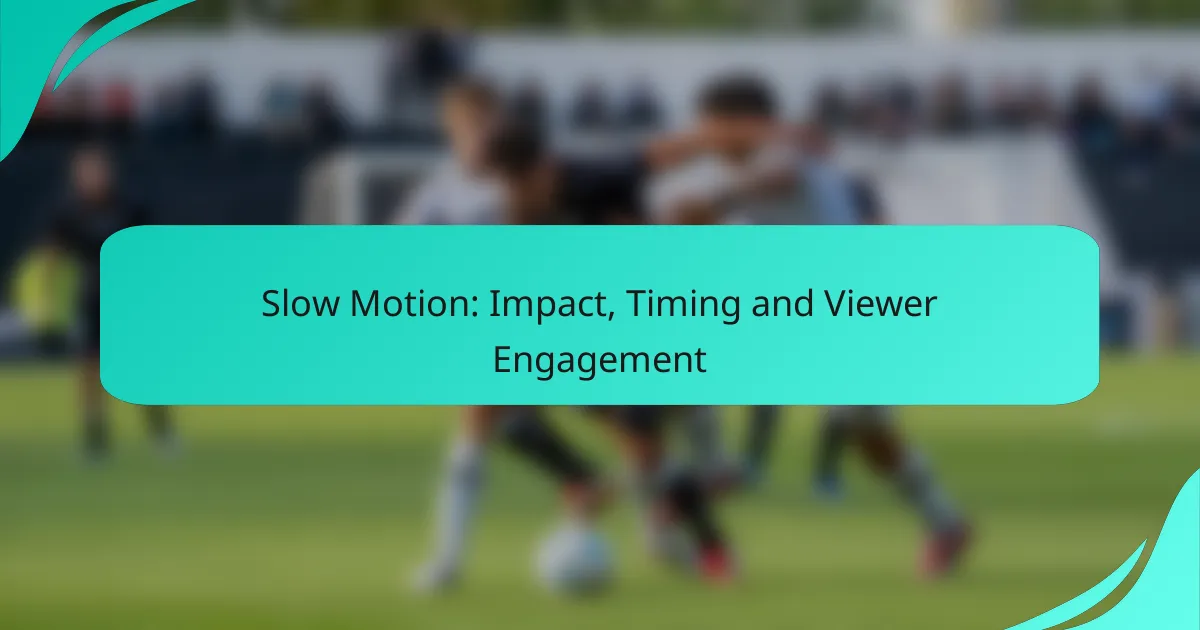Slow motion is a powerful tool in filmmaking that enhances viewer engagement by allowing audiences to experience moments with greater detail and emotional resonance. By stretching time, it highlights pivotal actions and reactions, creating a more immersive storytelling experience. Effective use of this technique involves careful timing and scene selection to maintain interest while balancing it with regular speed.
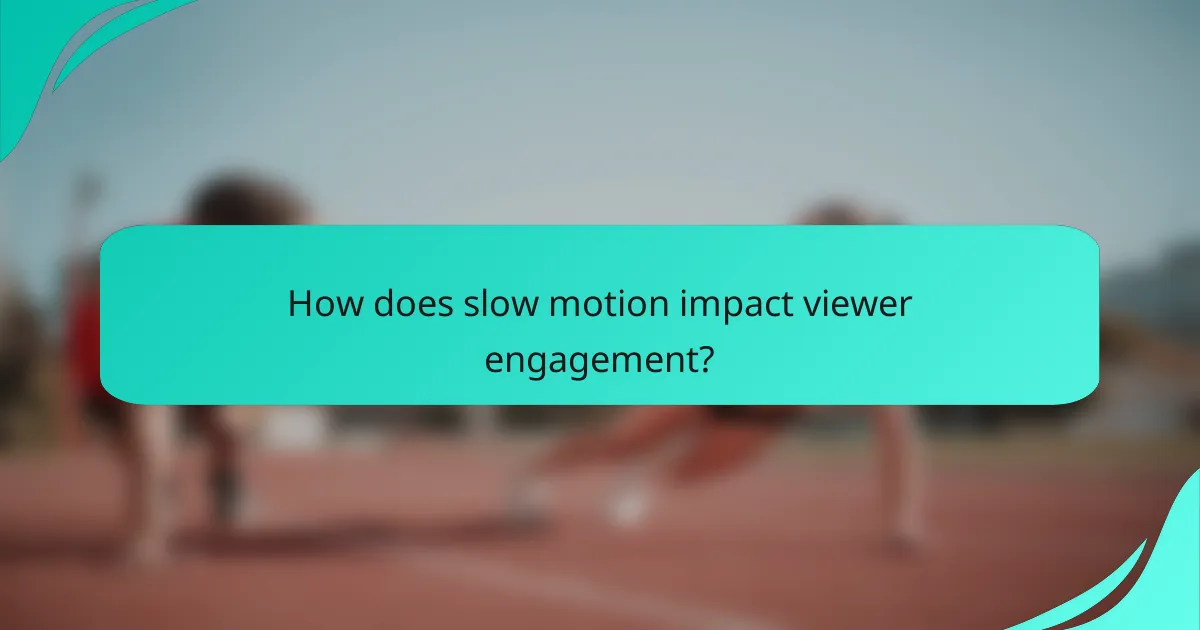
How does slow motion impact viewer engagement?
Slow motion significantly enhances viewer engagement by allowing audiences to experience moments in greater detail and emotional depth. This technique creates a more immersive viewing experience, drawing attention to specific actions and reactions that might otherwise go unnoticed.
Increased emotional connection
Slow motion fosters a stronger emotional connection by emphasizing characters’ facial expressions and reactions during pivotal moments. For instance, a slow-motion shot of a character’s joyful smile or a tearful farewell can evoke empathy and resonate with viewers on a deeper level.
By stretching out these moments, filmmakers can create a more impactful narrative, allowing the audience to fully absorb the emotional weight of the scene. This technique is particularly effective in dramatic or romantic genres where emotional stakes are high.
Enhanced visual clarity
Using slow motion improves visual clarity by allowing viewers to see intricate details that may be missed at normal speed. This is especially useful in action sequences, where fast movements can blur the action, making it difficult to follow.
For example, in sports broadcasts, slow motion can highlight the precise movements of athletes, showcasing their skills and techniques. This not only enhances understanding but also increases appreciation for the sport.
Heightened suspense and drama
Slow motion can heighten suspense and drama by prolonging critical moments, creating tension as viewers anticipate the outcome. This technique is often used in thrillers and action films, where a slow-motion shot of a bullet being fired or a character falling can amplify the stakes.
By extending these moments, filmmakers can manipulate pacing to keep audiences on the edge of their seats. It’s essential to use this technique judiciously; overuse can diminish its impact and lead to viewer fatigue.
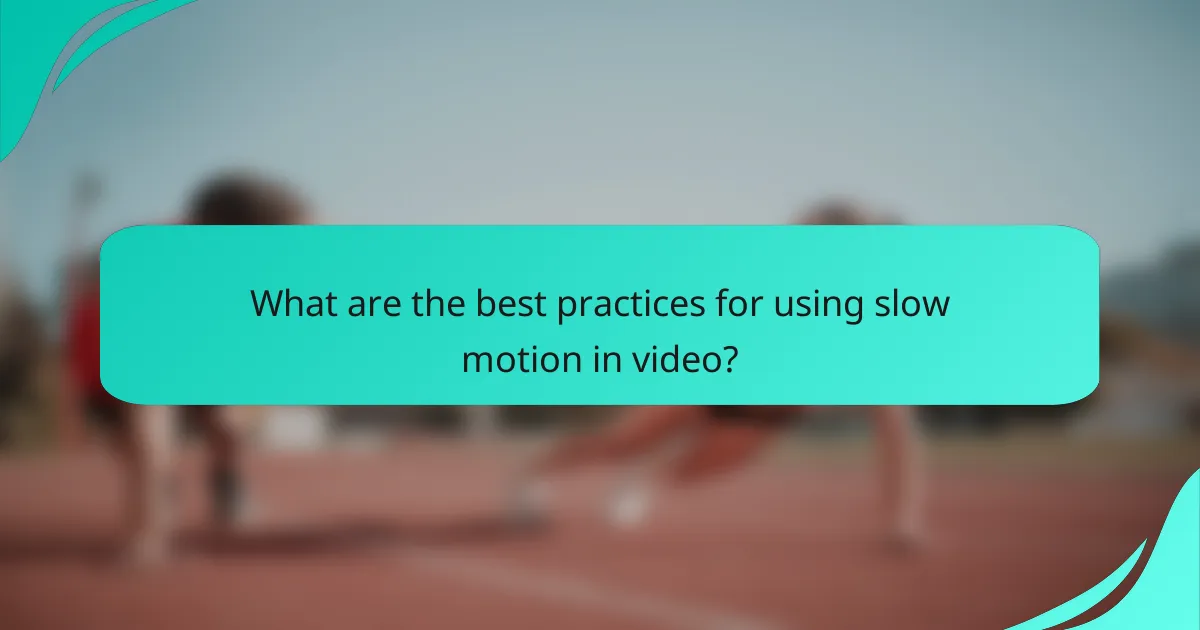
What are the best practices for using slow motion in video?
Effective use of slow motion in video enhances storytelling and viewer engagement. Best practices include careful timing, selecting appropriate scenes, and balancing slow motion with regular speed to maintain viewer interest.
Timing and pacing considerations
Timing is crucial when incorporating slow motion. Aim for a frame rate of at least 120 frames per second for smooth playback, which allows for a slowdown of up to five times without losing quality. Consider the pacing of your overall video; slow motion should complement the rhythm rather than disrupt it.
Be mindful of the emotional impact of timing. A well-timed slow-motion moment can heighten tension or evoke nostalgia, while poorly timed slow motion may feel jarring. Test different speeds to find the most effective pacing for your narrative.
Choosing the right scenes for slow motion
Select scenes that benefit from slow motion, such as action sequences, emotional moments, or visually striking visuals. For example, capturing a sports highlight or a dramatic facial expression can create a powerful impact when slowed down.
Evaluate the context of each scene. If the action is too fast or chaotic, slow motion may not add value. Instead, focus on moments where detail and emotion can be highlighted, ensuring that the slow motion serves a purpose in the storytelling.
Balancing slow motion with regular speed
Balancing slow motion with regular speed is essential to maintain viewer engagement. Use slow motion sparingly to avoid overwhelming the audience; a good rule of thumb is to limit it to a few key moments per video. This keeps the technique special and impactful.
Transitions between slow motion and regular speed should be smooth. Consider using cuts or fades to shift between speeds, ensuring that the viewer remains immersed in the narrative. A well-executed balance can enhance the overall viewing experience and emphasize critical moments effectively.
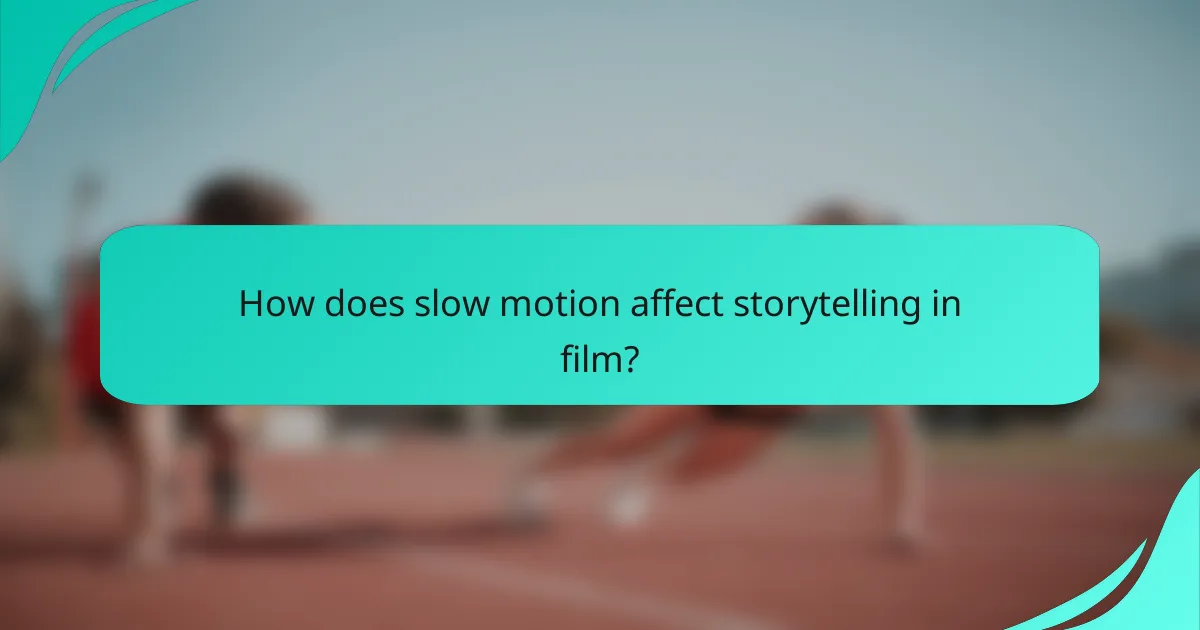
How does slow motion affect storytelling in film?
Slow motion enhances storytelling in film by allowing viewers to absorb critical moments with greater detail and emotional weight. It stretches time, enabling filmmakers to highlight pivotal scenes that might otherwise go unnoticed, thereby deepening audience engagement.
Emphasizing key moments
Using slow motion effectively emphasizes key moments by drawing attention to actions or emotions that are central to the narrative. For instance, a character’s reaction during a climactic event can be portrayed in slow motion to amplify its significance, making the audience feel the weight of the moment.
Filmmakers often employ slow motion during critical scenes, such as a dramatic reveal or a pivotal decision, to allow viewers to process the emotional impact. This technique can transform ordinary actions into extraordinary experiences, enhancing the overall storytelling.
Creating impactful transitions
Slow motion can serve as a powerful tool for creating impactful transitions between scenes. By slowing down the action at the end of one scene, filmmakers can create a seamless shift into the next, maintaining the emotional tone and keeping viewers engaged.
For example, a slow-motion shot of a character walking away can transition into a new setting, allowing the audience to absorb the emotional weight of the departure while smoothly moving the narrative forward. This technique helps maintain continuity and enhances the storytelling flow.
Influencing audience perception
Slow motion influences audience perception by altering how viewers interpret the pacing and emotional intensity of a scene. It can evoke feelings of nostalgia, tension, or drama, depending on how it is applied within the narrative context.
When used strategically, slow motion can create a sense of urgency or suspense, making viewers more invested in the outcome. For instance, a slow-motion chase scene can heighten tension, making each moment feel critical and engaging the audience’s emotions more deeply.
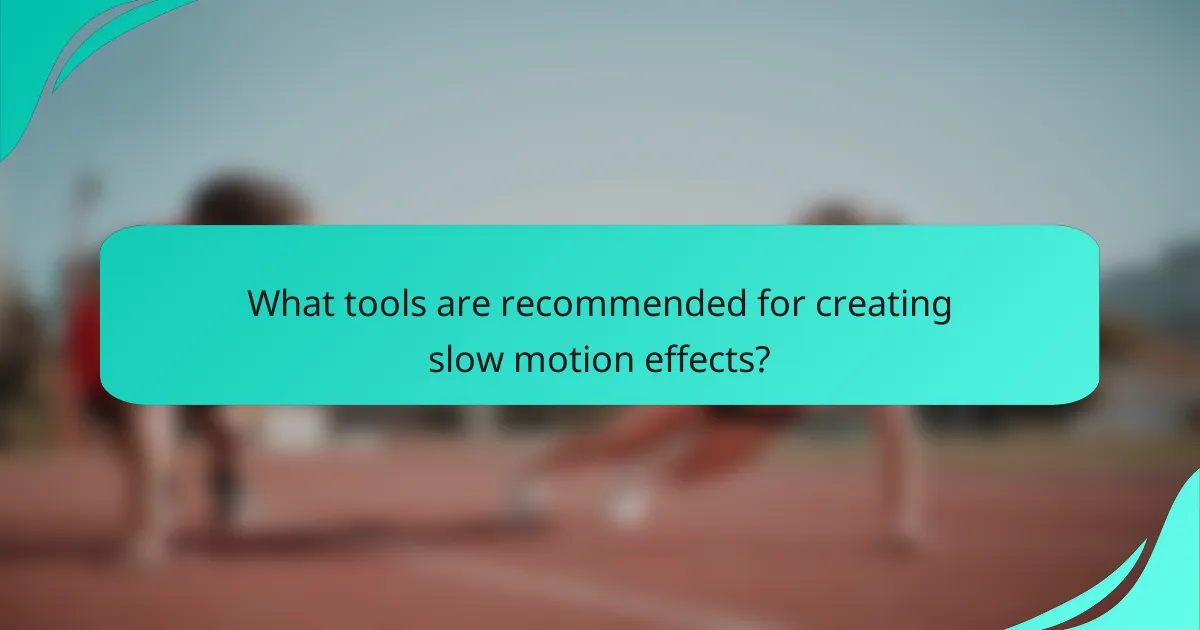
What tools are recommended for creating slow motion effects?
To create effective slow motion effects, software like Adobe Premiere Pro and Final Cut Pro, along with high-speed cameras, are commonly recommended. These tools allow for precise control over timing and visual quality, enhancing viewer engagement.
Adobe Premiere Pro
Adobe Premiere Pro is a versatile video editing software that offers robust slow motion capabilities. Users can adjust the speed of clips by right-clicking on the video, selecting ‘Speed/Duration,’ and entering a lower percentage to create the desired slow motion effect.
For best results, consider using the ‘Optical Flow’ feature, which generates intermediate frames for smoother motion. This is particularly useful when slowing down footage significantly, as it minimizes choppiness and enhances fluidity.
Final Cut Pro
Final Cut Pro is another powerful editing tool that excels in creating slow motion effects. Users can apply slow motion by selecting a clip, navigating to the ‘Retime’ menu, and choosing ‘Slow’ to adjust the speed. This software provides options for both frame blending and optical flow to improve visual quality.
When working with Final Cut Pro, it’s advisable to shoot at higher frame rates (like 60 fps or more) to achieve smoother slow motion. This ensures that the playback remains visually appealing and engaging for the audience.
High-speed cameras
High-speed cameras are essential for capturing footage that can be slowed down without losing quality. These cameras can record at frame rates ranging from hundreds to thousands of frames per second, allowing for dramatic slow motion effects.
When selecting a high-speed camera, consider factors such as resolution, light sensitivity, and storage capacity. Shooting in well-lit environments can significantly enhance the quality of slow motion footage, as high-speed recording often requires more light to maintain clarity.
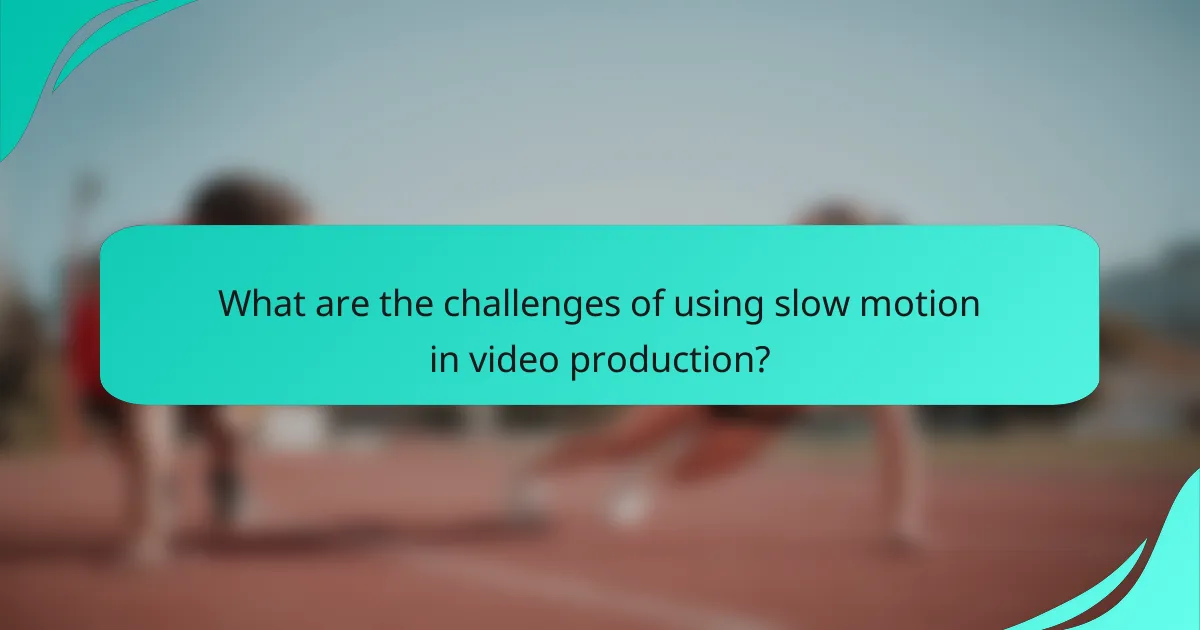
What are the challenges of using slow motion in video production?
Using slow motion in video production presents several challenges, including increased costs, technical limitations, and the risk of viewer fatigue. Understanding these issues is crucial for filmmakers to effectively incorporate slow motion without compromising their projects.
Increased production costs
Implementing slow motion can significantly raise production costs. This is primarily due to the need for high-speed cameras, which are often more expensive than standard equipment. Additionally, the post-production process may require more time and resources, further inflating the budget.
Filmmakers should consider budgeting for these additional expenses early in the planning stage. Allocating funds for specialized equipment and skilled personnel can help mitigate financial strain during production.
Technical limitations of equipment
Not all cameras are capable of capturing high-quality slow motion footage. Many consumer-grade cameras lack the necessary frame rates, which can lead to choppy or low-resolution results. High-speed cameras, while effective, may require specific settings and expertise to operate correctly.
Filmmakers should assess their equipment’s capabilities before attempting slow motion shots. Testing different settings and understanding the limitations of their gear can prevent disappointing outcomes during filming.
Potential for viewer fatigue
Excessive use of slow motion can lead to viewer fatigue, diminishing the impact of the technique. Audiences may become desensitized to slow motion effects if they are overused or poorly timed, which can detract from the overall storytelling experience.
To avoid this, filmmakers should use slow motion strategically, ensuring it enhances key moments rather than becoming a repetitive element. Balancing slow motion with other cinematic techniques can maintain viewer engagement and interest throughout the production.
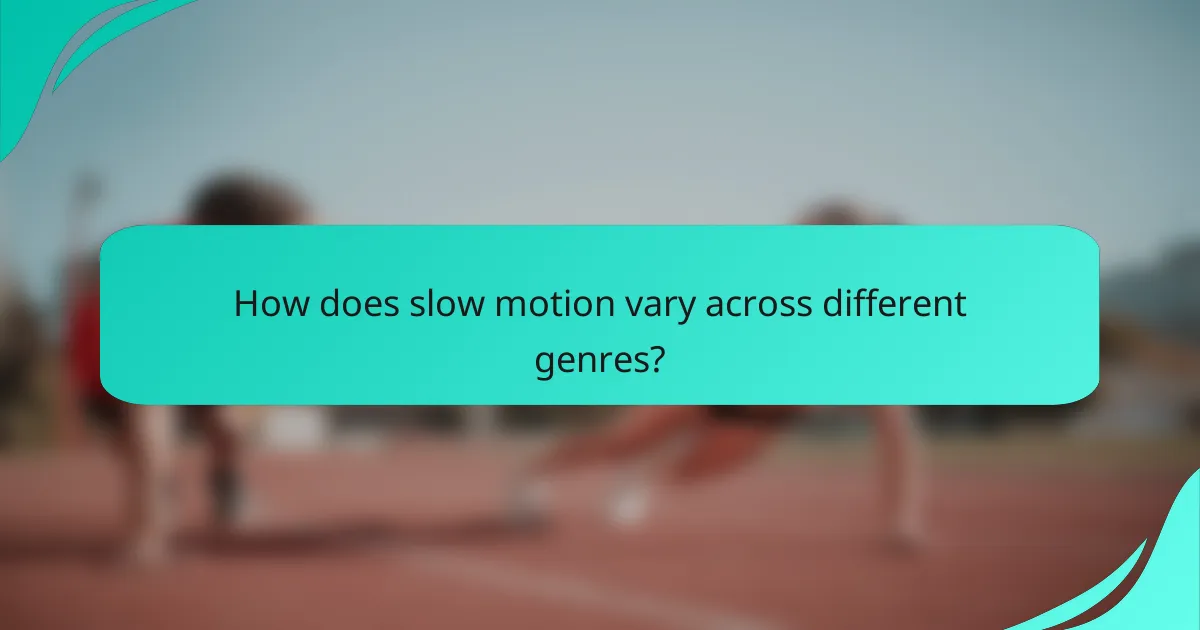
How does slow motion vary across different genres?
Slow motion techniques differ significantly across genres, impacting how viewers perceive action, emotion, and detail. Each genre employs slow motion to enhance storytelling, whether to amplify tension in action scenes or to capture the beauty of nature in documentaries.
Action films
In action films, slow motion is often used to heighten dramatic moments, allowing viewers to savor intense sequences such as fight scenes or explosions. This technique can create a sense of urgency and impact, drawing attention to critical details that might otherwise be missed.
Commonly, filmmakers use slow motion at frame rates ranging from 120 to 240 frames per second, enabling smooth playback at standard speeds. However, excessive use can detract from pacing, so it’s crucial to balance its application with the overall rhythm of the scene.
Documentaries
Documentaries utilize slow motion to emphasize natural beauty or significant moments, providing viewers with a deeper understanding of the subject matter. This technique allows for a more contemplative viewing experience, inviting audiences to appreciate intricate details in wildlife or human interactions.
In this genre, slow motion is often applied subtly, with frame rates typically around 60 to 120 frames per second. This moderate approach helps maintain the documentary’s authenticity while enhancing emotional engagement without overwhelming the viewer.
